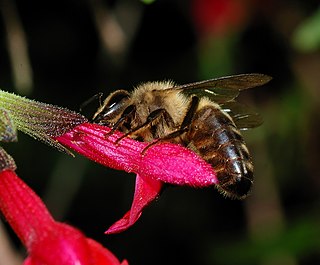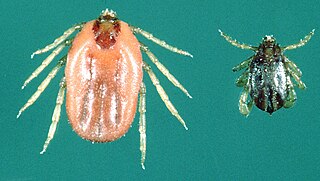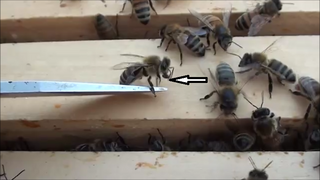
Roger A. Morse, Ph.D. was an American bee biologist who taught many beekeepers both the rudiments and the finer practices, through his research and publications. During his long career, three new parasites of the honeybee, acarine mite, varroa mite, and African small hive beetle were introduced to the United States. These, along with the Africanized honeybee and pesticide kills were all important beekeeping issues. Morse was extensively involved in research on each of these and provided guidance to the beekeeping industry.

The European dark bee is a subspecies of the western honey bee, evolving in central Asia, with a proposed origin of the Tien Shan Mountains and later migrating into eastern and then northern Europe after the last ice age from 9,000BC onwards. Its original range included the southern Urals in Russia and stretched through northern Europe and down to the Pyrenees. They are one of the two members of the 'M' lineage of Apis mellifera, the other being in western China. Traditionally they were called the Black German Bee, although they are now considered endangered in Germany. However today they are more likely to be called after the geographic / political region in which they live such as the British Black Bee, the Native Irish Honey Bee, the Cornish Black Bee and the Nordic Brown Bee, even though they are all the same subspecies, with the word "native" often inserted by local beekeepers, even in places where the bee is an introduced foreign species. It was domesticated in Europe and hives were brought to North America in the colonial era in 1622 where they were referred to as the English Fly by the Native Americans.

Varroa destructor, the Varroa mite, is an external parasitic mite that attacks and feeds on honey bees and is one of the most damaging honey bee pests in the world. A significant mite infestation leads to the death of a honey bee colony, usually in the late autumn through early spring. Without management for Varroa mite, honey bee colonies typically collapse within 2 to 3 years in temperate climates. These mites can infest Apis mellifera, the western honey bee, and Apis cerana, the Asian honey bee. Due to very similar physical characteristics, this species was thought to be the closely related Varroa jacobsoni prior to 2000, but they were found to be two separate species after DNA analysis.

The Russian honeybee refers to honey bees that originate in the Primorsky Krai region of Russia. This strain of bee was imported into the United States in 1997 by the USDA Agricultural Research Service's Honeybee Breeding, Genetics & Physiology Laboratory in Baton Rouge, Louisiana, in response to severe declines in bee populations caused by infestations of parasitic mites, and has been used in breeding programs to improve existing stocks. Many Russian queens openly mate with drones from various stock, creating colonies that are genetically hybrid. Some of these 'uncontrolled' hybrids may exhibit "increased aggressiveness, reduced honey production and a decrease in their ability to withstand mites and detrimental expressions of other traits as well."

Acaricides are pesticides that kill members of the arachnid subclass Acari, which includes ticks and mites. Acaricides are used both in medicine and agriculture, although the desired selective toxicity differs between the two fields.

Varroa is a genus of parasitic mesostigmatan mites associated with honey bees, placed in its own family, Varroidae. The genus was named for Marcus Terentius Varro, a Roman scholar and beekeeper. The condition of a honeybee colony being infested with Varroa mites is called varroosis.

Varroa jacobsoni is a species of mite that parasitises Apis cerana. The more damaging Varroa destructor was previously included under the name V. jacobsoni, but the two species can be separated on the basis of the DNA sequence of the cytochrome oxidase I gene in the mitochondrial DNA.

Amitraz is a non-systemic acaricide and insecticide and has also been described as a scabicide. It was first synthesized by the Boots Co. in England in 1969. Amitraz has been found to have an insect repellent effect, works as an insecticide and also as a pesticide synergist. Its effectiveness is traced back on alpha-adrenergic agonist activity, interaction with octopamine receptors of the central nervous system and inhibition of monoamine oxidases and prostaglandin synthesis. Therefore, it leads to overexcitation and consequently paralysis and death in insects. Because amitraz is less harmful to mammals, amitraz is among many other purposes best known as insecticide against mite- or tick-infestation of dogs. It is also widely used in the beekeeping industry as a control for the Varroa destructor mite, although there are recent reports of resistance.

Deformed wing virus (DWV) is an RNA virus, one of 22 known viruses affecting honey bees. While most commonly infecting the honey bee, Apis mellifera, it has also been documented in other bee species, like Bombus terrestris, thus, indicating it may have a wider host specificity than previously anticipated. The virus was first isolated from a sample of symptomatic honeybees from Japan in the early 1980s and is currently distributed worldwide. It is found also in pollen baskets and commercially reared bumblebees. Its main vector in A. mellifera is the Varroa mite. It is named after what is usually the most obvious deformity it induces in the development of a honeybee pupa, which is shrunken and deformed wings, but other developmental deformities are often present.

Fluvalinate is a synthetic pyrethroid chemical compound contained as an active agent in the products Apistan, Klartan, and Minadox, that is an acaricide, commonly used to control Varroa mites in honey bee colonies, infestations that constitute a significant disease of such insects.

Coumaphos is a nonvolatile, fat-soluble phosphorothioate with ectoparasiticide properties: it kills insects and mites. It is well known by a variety of brand names as a dip or wash, used on farm and domestic animals to control ticks, mites, flies and fleas.

The Asian blue tick is an economically important tick that parasitises a variety of livestock species especially cattle, on which it is the most economically significant ectoparasite in the world. It is known as the Australian cattle tick, southern cattle tick, Cuban tick, Madagascar blue tick, and Puerto Rican Texas fever tick.
Varroa sensitive hygiene (VSH) is a behavioral trait of honey bees (Apis mellifera) in which bees detect and remove bee pupae that are infested by the parasitic mite Varroa destructor. V. destructor is considered to be the most dangerous pest problem for honey bees worldwide. VSH activity results in significant resistance to the mites.
Beekeeping is first recorded in Ireland in the seventh century. It has seen a surge in popularity in modern times, with the membership of beekeeping associations exceeding 4,500. The median average number of hives per beekeeper is three hives, while the average honey output per hive is 11.4 kg. The growth in the practice has occurred despite increased pressures on bees and beekeepers due to parasites, diseases and habitat loss.
Dr. Marian Jeliński was born in Siemirowice, in 1949. Jeliński is a recognized authority in bee diseases and an active member of the Kashubian community. He is involved in a range of activities focusing on the preservation of the Kashubian language and culture. Jeliński is also known for his support of Kashubian embroidery and building bridges between Kashubian communities in Poland and Canada. He and his wife, Alicja, have two sons and currently live in Żukowo, near Gdańsk, Poland.

Etoxazole is a narrow spectrum systemic acaricide used to combat spider mites. It targets a variety of mites in the egg, larvae and nymph stages however not the adult stage. It also exhibits insecticidal activity towards aphids, the green rice leafhopper and diamondback moth. The mode of action was originally suspected to inhibit the molting process but has since been shown to inhibit chitin synthesis. Resistance due to its high efficacy and cross resistance when used with other acaricides are both of concern similar to was seen in the fast development of cross resistance in the previous generation of acaricides. The LC50 for resistant mite strains has been observed over 100,000 times greater than that of susceptible strains. Thus resistance management strategies are important in order to limit the increase of etoxazole resistant mite strains.

Slow bee paralysis virus (SBPV) is a virus discovered in England in 1974 that infects honeybees, bumblebees, and silkworms through Varroa destructor mite infestations. The virus causes paralysis in the front two pairs of legs of adult bees eventually killing its hosts. The virus is in the iflaviridae family of viruses. Infection by iflaviridae viruses is among the leading cause of death of honeybee colonies. As bees and silkworms are of great economic and biological importance, the virus is the subject of ongoing research.

Mite Biting is claimed to be a natural defensive behavior of some honey bees to fight off the ectoparasitic mites Varroa destructor. This behavior has been studied since the late 1990s for honeybee breeding and improvement of honeybee stocks towards mite resistance. Krispn Given and Dr. Greg Hunt at Purdue University started a hierarchical selective breeding program in 1997–present for increased mite-biting/grooming behavior of European honey bee. A group of Midwest bee breeders visiting the Purdue bee lab were inspired to start the Heartland Honey Bee Breeders Cooperative as a result of their work.
Friedrich Ruttner was an Austrian SA-member, NSDAP member, SS-physician, neurologist, zoologist and bee expert. He became internationally known for his advances in honey bee breeding, instrumental insemination, classification of various subspecies and as a co-founder of Apidologie.
A resistance gene is any gene producing resistance against an agent. This gene may produce:














